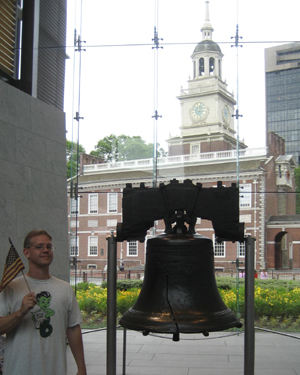 Bob and I had made our way from Atlantic City to Philadelphia, which was about 90 minutes away. We arrived at about 11:40am on the morning of Tuesday, June 16, 2009. We parked the car at the Independence Visitors Center parking garage and set out on a very long and tiring day’s adventures on foot. In fact, we saw so much in Philadelphia, which in essence was where the United States was born, that I am breaking this location into two separate postings. The sites represented in this first volume represent about three hours worth of activity – or roughly half the time it will take to actually complete this posting. I had not visited Philadelphia since 1986, at which time I had only seen a few of the locations that I would see this day.
Bob and I had made our way from Atlantic City to Philadelphia, which was about 90 minutes away. We arrived at about 11:40am on the morning of Tuesday, June 16, 2009. We parked the car at the Independence Visitors Center parking garage and set out on a very long and tiring day’s adventures on foot. In fact, we saw so much in Philadelphia, which in essence was where the United States was born, that I am breaking this location into two separate postings. The sites represented in this first volume represent about three hours worth of activity – or roughly half the time it will take to actually complete this posting. I had not visited Philadelphia since 1986, at which time I had only seen a few of the locations that I would see this day.
The first stop in Philadelphia was a biggie – the Christ Church Burial Ground. This cemetery belongs to the Christ Church, which was founded in 1695 and served as the worship center to many of the Revolutionary War bigwigs, among them George Washington. The church is actually located a few blocks away. In this burial ground are five signers of the Declaration of Independence, the most famous being Benjamin Franklin (1706-1790), one of the most famous and important figures in American History. Inventor, writer, scholar, and statesman, Franklin is the only American who signed not only the Declaration of Independence and the United States Constitution, but also the Treaty of Paris and the Treaty of Alliance (with France).
To date, this is the only burial ground I have ever entered that charged a small admission to get in…and set up a little trailer to peddle souvenirs. But I suppose it all went to support the upkeep of the cemetery. Ben Franklin is located at the front of the cemetery and can actually be seen from the sidewalk outside the iron fence. Bob had been here as a child and this had been how he had seen the grave in the past.
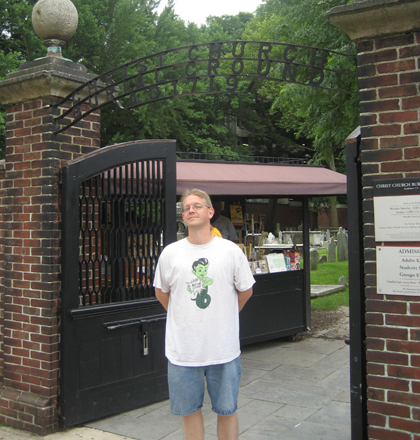
Outside the Christ Church Burial Ground
Incidentally, there are many possible origins and reasons why people leave pennies on graves (a practice in which Bob routinely partakes). One of them is that it began in force with Franklin’s funeral in honor of the phrase he coined (no pun intended) in his Poor Richard’s Almanac “A penny saved is a penny earned” (which originally was quoted as “A penny saved is twopence dear”).

Memorial tablet to Benjamin Franklin

Declaration of Independence signer and United States Constitution signer Benjamin Franklin…and some pennies
Elsewhere in the burial ground were not only four more signers of the Declaration of Independence, but a variety of other famous people. Of note was Michael Hillegas (1728-1804), the first Treasurer of the United States.
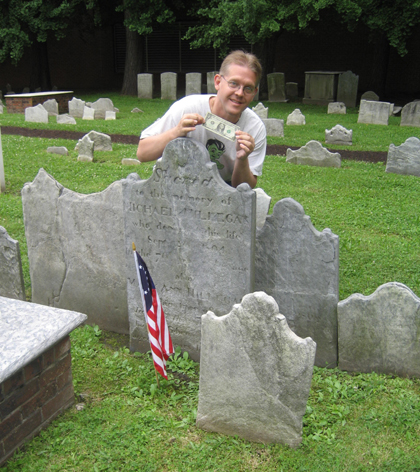
Michael Hillegas, our first Treasurer
As you can see in the above photo, many of the graves in the burial ground had been badly damaged, worn, or completely destroyed, so it was often impossible to find the exact burial spot of the 4000 people buried here. In fact, three of the remaining Declaration signers only had cenotaphs honoring them because, although records indicate that they are buried there, their actual location within the cemetery is uncertain.
However DOI signer Dr. Benjamin Rush (1745-1813) is still clearly marked. In addition to his involvement in the Continental Congress, he is also known as the man who helped reconcile the friendship between John Adams and Thomas Jefferson and encouraged them to write one another later in life.
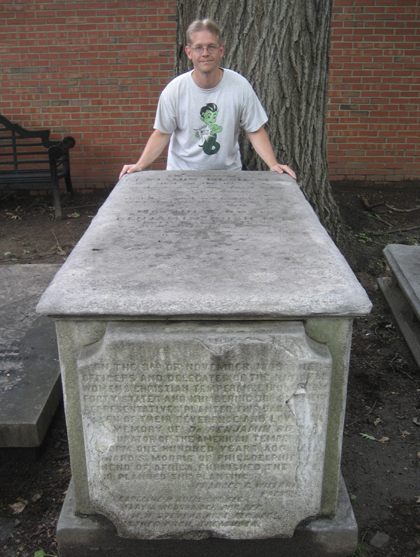
Declaration of Independence signer Benjamin Rush
Francis Hopkinson (1737-1791) was actually a delegate from New Jersey as signatory to the Declaration of Independence. Some of his supporters claim that he also played a key role in the design of our nation’s first American flag. Although the marker placed on Hopkinson’s grave is clearly modern, one of the workers at the cemetery claimed that they were fairly certain that it is in the correct spot.
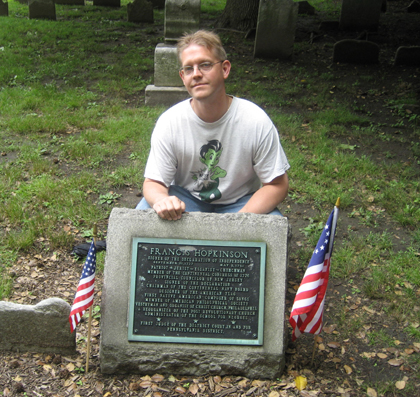
Declaration of Independence signer Francis Hopkinson
The final two signers at the Christ Church Burial Ground, Joseph Hewes (1730-1779) and George Ross (1730-1779), not only share the same birth and death year, but also the fact that no one knows where they actually lie within the grounds. Hewes was actually from New Jersey and signed the DOI as a delegate for North Carolina. Ross actually represented Pennsylvania, although from New Castle, Delaware.
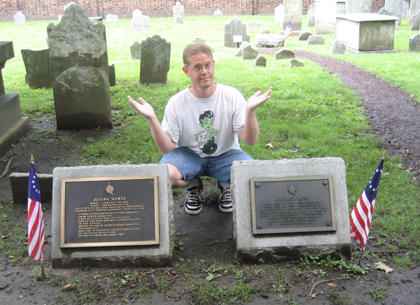
Cenotaph markers for Declaration of Independence signers Joseph Hewes and George Ross
After we had roamed the burial grounds for about 40 minutes, we commenced with the rest of our walking tour of Philadelphia. Along the way to the St. Mary’s Catholic Church cemetery, we stopped by the Keys To Community sculpture of Ben Franklin by James Peniston that had been erected in 2007. Not old, but cool.
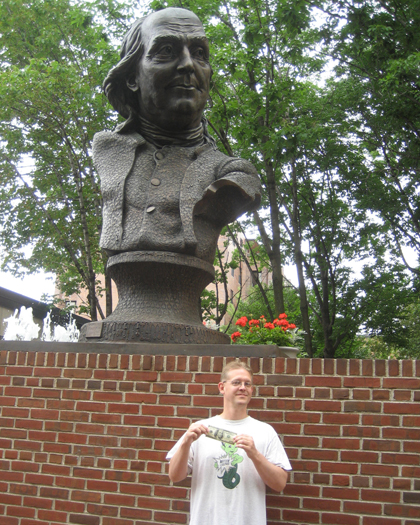
Boy that Ben Franklin had a big head. Whipping out one of Bob’s hundred dollar bills in Philadelphia probably wasn’t the smartest move either.
The St. Mary’s Catholic Church cemetery held only one final resting place of interest, that of Thomas Fitzsimons (1741-1811) – Pennsylvania statesman from Philadelphia who represented the state in Continental Congress, the Constitutional Convention, and United States Congress. He was one of only two Catholic signers of the United States Constitution.
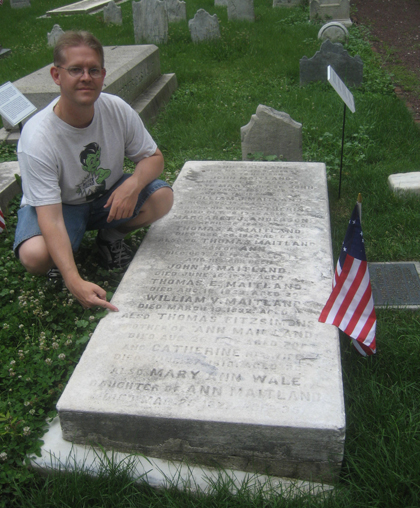
United States Constitution signer Thomas Fitzsimons
Our next stop was a brief one. Known as the Todd House, this middle-class eighteenth century dwelling was the home of John Todd, first husband to future First Lady Dolley Madison. She was only married to Mr. Todd from 1790-93, before he passed away. The following year, Dolley would marry James Madison, whom it is speculated she met in the parlor in this very house. This house did offer tours, but we opted not to partake in one, instead simply posing outside the dwelling.
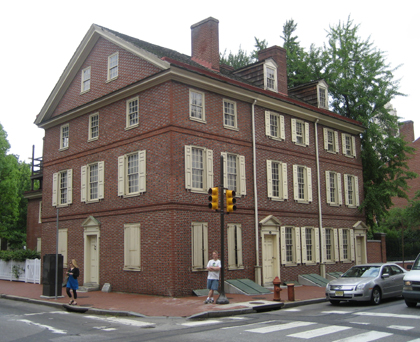
Outside the Todd house, former home of Dolley Madison
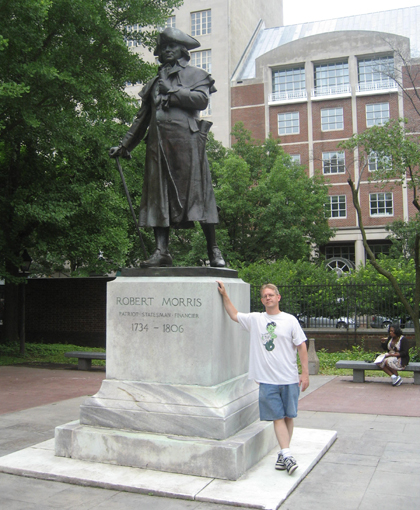
Statue honoring Robert Morris, signer of three major U.S. documents
Fifteen minutes later, Bob and I were visiting Franklin Court, the area where the home of Benjamin Franklin once stood. The house is now gone, but a representative ‘outline’ of the abode has been constructed, indicating where the house once stood. The land here was owned by Franklin’s future wife Deborah’s family, and when the two got married they inherited it.
Adjoining the property is a nice Benjamin Franklin museum that contains some articles of interest from his life. I plopped myself in the film screening room for a short time to catch some of The Real Ben Franklin.
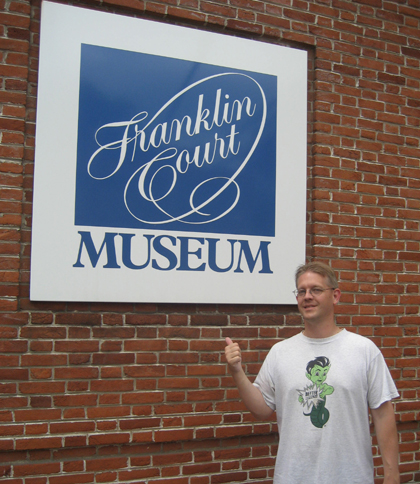
Outside the Benjamin Franklin Museum
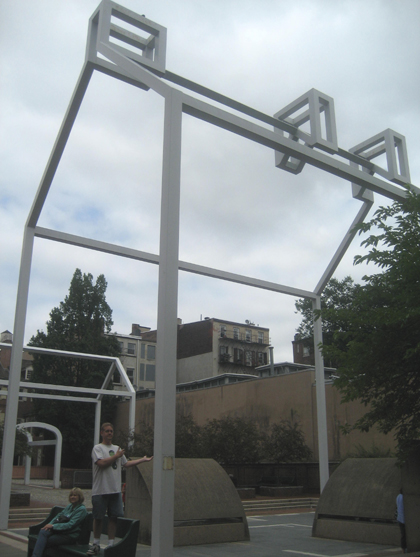
The outline of Franklin’s home…and a lady on a park bench
It was almost quarter of two when Bob and I decided to stop at a hotdog stand for a nosh. I’m quite into having hotdogs in various cities, but I most sincerely regret that we somehow managed to escape Philadelphia with a Philly Cheesesteak. A bit more on that later. Oh, and I did make the fatal mistake of trying to enter a crummy souvenir store with a bite of my hotdog remaining. I was sternly told by the shop owner that I couldn’t bring food inside, to which I sternly told them what they could do with the magnet that I was going to purchase.
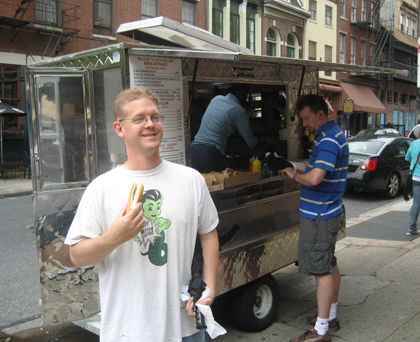
A hot dog in Philadelphia
After scarfing that down, we walked on over to the other section of the Christ Church, where there was another scad of important signers of both the Declaration of Independence and the U.S. Constitution interred.
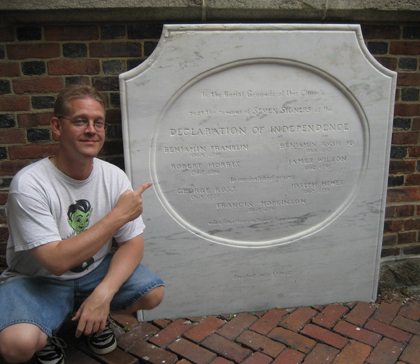
Plaque found outside the Christ Church indicating the seven DOI signers who are buried on their grounds. This was placed her on July 4, 1926, as the DOI was turning 150 years old
Pierce Butler (1744-1822) represented South Carolina in the Continental Congress, U.S. Senate, and at the Constitutional Convention – and of course was a signer of the U.S. Constitution.
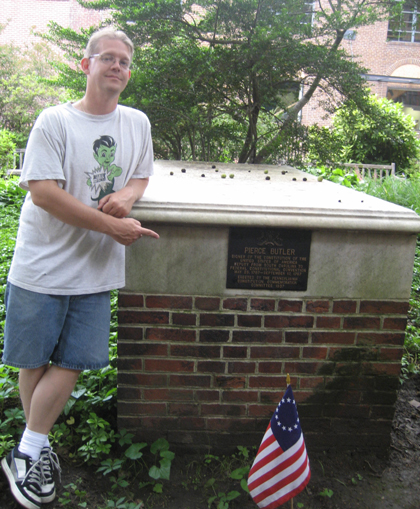
United States Constitution signer Pierce Butler
Jacob Broom (1752-1810) hailed from Wilmington, Delaware and was a delegate to the Constitutional Convention and ultimately a signer of the U.S. Constitution, despite his lack of involvement with national politics beforehand.
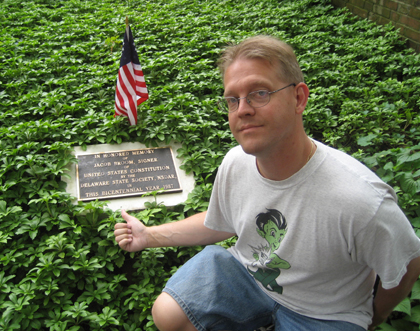
United States Constitution signer Jacob Broom
Pennsylvanian Robert Morris (1734-1806) was unique in that he was a signer to three vitally important documents: the Declaration of Independence, the Articles of the Confederation, and the United States Constitution.
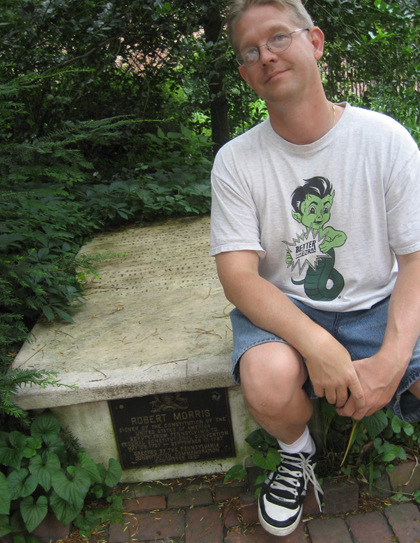
Declaration of Independence signer and United States Constitution signer Robert Morris
And finally (for now) is James Wilson (1742-1798). He was twice elected to the Continental Congress, appointed by George Washington as one of the six original Justices of the Supreme Court, and a signer of the Declaration of Independence.
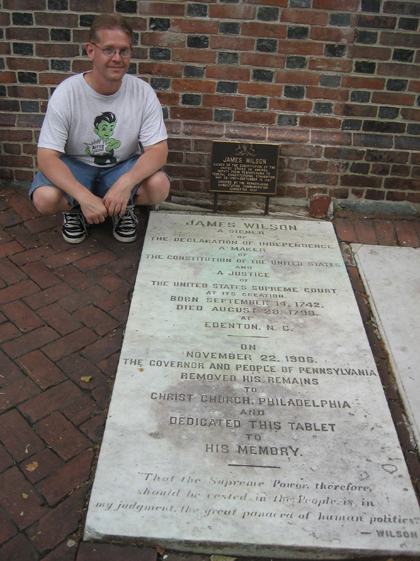
Declaration of Independence signer James Wilson
After Bob and I finished up at Christ Church, we took a rather lengthy walk to the Betsy Ross House, passing by Penn’s Landing along the way. As we neared the house, I saw two gals in full Revolutionary era garb and posed for a picture with them. Somehow in the melee, I managed to lose my camera case right then and there. Although I scoured the area, it was nowhere to be found. I’m wondering if it ended up in one of the gals’ baskets.
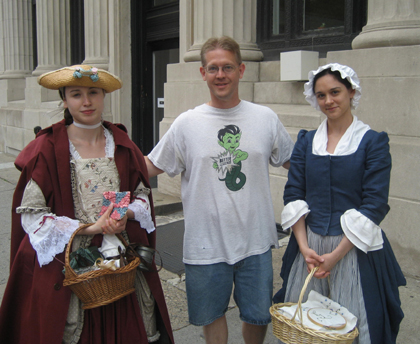
With the ladies who may or may not have stolen my camera case
We did not go in the Betsy Ross house but rather just stared longingly at the exterior. The house is generally recognized as the location where Betsy Ross, living here at the time, made the first American Flag. And although we didn’t know it at the time, the bones that were thought to belong to her are now interred in the courtyard of the house.
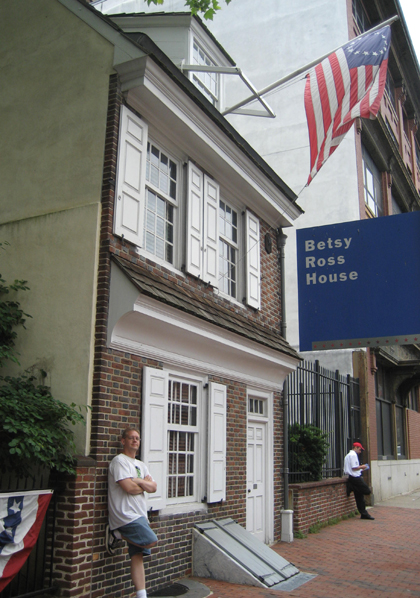
Outside the Betsy Ross house. The other guy is copying me.
And last for now, but certainly not least, was the Liberty Bell Center located just a few blocks away. I had seen the bell once before during my 1986 visit and it was nice to see it again. Located inside a small museum with a great view of Independence Hall behind it, the bell sat in all its cracked glory. Legend has it that this bell was rang on July 8, 1776, to summon the townspeople for a reading of the Declaration of Independence. It had been previously rung two years earlier to announce the opening of the First Continental Congress and one year earlier after the Battle of Lexington and Concord. Bob and I took so long getting pictures that we were happy with – while other tourists waited in line – that Bob remarked, “we could have made a movie by now!”
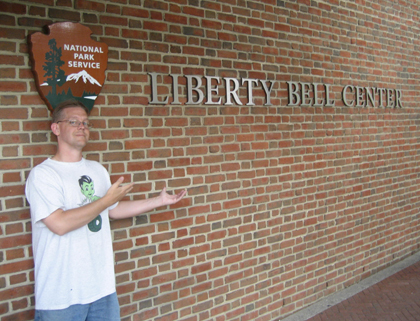
Getting ready to check out the Liberty Bell again
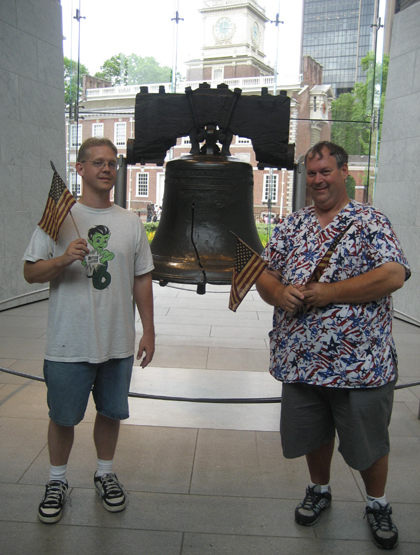
A cracked bell with equally cracked tourists
Yes, just three hours had elapsed since we had first pulled into the city of Philadelphia. There would still be much more to see on this patriotic day.
Philly will continue…
Do you know if the Todd House was one residence or three? There are three doors. If it was just one, that would be one nice middle-class residence!
Was that an outline of Franklin’s home, or was it a glass house?
Chris
October 1st, 2009
The Todds only lived on the portion of the house on the left, sharing a privy with the two neighbor houses. In fact, the living quarters were only on the top floor, with a parlor on the second level, and Todd’s law office on the bottom floor.
Just an outline. No glass. Ass.
Brad
October 1st, 2009
So they were privy to the privy?
Chris
October 1st, 2009
Wow, this entry was more interesting and enlightening than any of the history classes I took in high school or college!
Randy Skretvedt
October 4th, 2009
great picture of dolly madsion’s home we found it for a report on her.
Amy Cooke
October 24th, 2009
Nice Try for picture about my distant relative of Uncle Thomas Fitzsimons. I know more than you do. Check out @ marble stone on sidewalk on Chestnut Street on between Front and 2nd St. ” Do not open until July 4,2076″ which my most distant relative’s value items and many document proof. I already know what is in there. Sorry, my future family relatives will own city of Philadelphia, PA someday.
Danny
February 4th, 2011